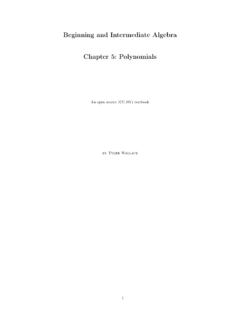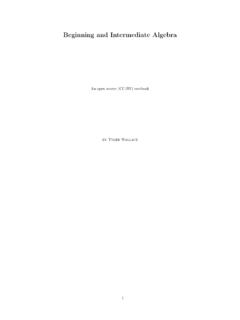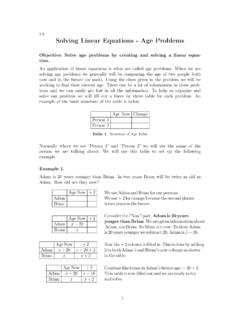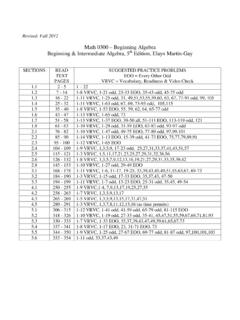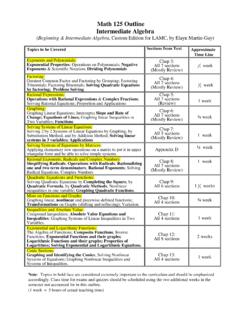Transcription of Beginning and Intermediate Algebra Chapter 1: …
1 Beginning and Intermediate AlgebraChapter 1: Linear EquationsAn open source (CC-BY) textbookbyTylerWallace1? Beginning and Intermediate Algebra by Tyler Wallace is licensed under a Creative CommonsAttribution Unported License. ( )You are free: to Share: to copy, distribute and transmit the work to Remix: to adapt the workUnder the following conditions: Attribution: You must attribute the work in the manner specified by the author orlicensor (but not in any way that suggests that they endorse you or your use of thework).With the understanding that: Waiver: Any of the above conditions can be waived if you get permission from the copy-right holder. Public Domain: Where the work or any of its elements is in the public domain underapplicable law, that status is in no way affected by the license. Other Rights: In no way are any of the following rights affected by the license: Your fair dealing or fair use rights, or other applicable copyright exceptions andlimitations; The author s moral rights; Rights other persons may have either in the work itself or in how the work is usedsuch as publicity or privacy rights Notice: For any reuse or distribution, you must make clear toothers the license term ofthis work.
2 The best way to do this is with a link to the following web page: is a human readable summary of the full legal code which can be read at the followingURL: 1: Linear Linear Equations - One Step EquationsSolving linear equations is an important and fundamental skill in Algebra . Inalgebra, we are often presented with a problem where the answer is known, butpart of the problem is missing. The missing part of the problem is what we seekto find. An example of such a problem is shown +16= 4 Notice the above problem has a missing part, or unknown, thatis marked byx. Ifwe are given that the solution to this equation is 5, it could be plugged into theequation, replacing thexwith 5. This is shown in Example ( 5) +16= 4 Multiply4( 5) 20+16= 4 Add 20+16 4 = 4 True!Now the equation comes out to a true statement! Notice also that if anothernumber, for example,3, was plugged in, we would not get a true statement asseen in Example (3) +16= 4 Multiply4(3)12+16= 4 Add 12+1628 4 False!
3 Due to the fact that this is not a true statement, this demonstates that3is notthe solution. However, depending on the complexity of the problem, this guessand check method is not very efficient. Thus, we take a more algebraic approachto solving equations. Here we will focus on what are called one-step equations orequations that only require one step to solve. While these equations often seemvery fundamental, it is important to master the pattern for solving these problemsso we can solve more complex ProblemsTo solve equations, the general rule is to do the opposite. For example, considerExample + 7 = 5 The7is added to thex3 7 7 Subtract7from both sides to get rid of itx= 12 Our solution!Then we get our solution,x= 12. The same process is used in each of the fol-lowing +x= 8 4 4x= 47 =x+ 9 9 9 2 =x5 = 8 +x 8 8 3 =xTable ExamplesSubtraction ProblemsIn a subtraction problem, we get rid of negative numbers by adding them to bothsides of the equation.
4 For example, consider Example 5 = 4 The5is negative,or subtracted fromx+ 5 + 5 Add5to both sidesx= 9 Our Solution!Then we get our solutionx= 9. The same process is used in each of the followingexamples. Notice that each time we are getting rid of a negative number 7. 6 +x= 2+ 6+ 6x= 4 10=x 7+ 7 + 7 3 =x5 = 8 +x+ 8 + 813=xTable ExamplesMultiplication ProblemsWith a multiplication problem, we get rid of the number by dividing on bothsides. For example consider Example Variable is multiplied by444 Divide both sides by4x= 5 Our solution!Then we get our solutionx= 54 With multiplication problems it is very important care is taken with signs. Ifxismultiplied by a negative then we will divide by a negative. This is shown inexample 9. 5x=30 Variable is multiplied by 5 5 5 Divide both sides by 5x= 6 Our Solution!The same process is used in each of the following examples.
5 Notice how negativeand positive numbers are handeled as each problem is 2488x= 3 4x= 20 4 4x= 542= 7x776 =xTable ExamplesDivision Problems:In division problems, we get rid of the denominator by multiplying on both example consider Example 3 Variable is divided by5(5)x5= 3(5)Multiply both sides by5x= 15 Our Solution!Then we get our solutionx= 15. The same process is used in each of the fol-lowing 7= 2( 7)x 7= 2( 7)x=14x8= 5(8)x8= 5(8)x=40x 4= 9( 4)x 4= 9( 4)x= 36 Table ExamplesThe process described above is fundamental to solving equations. once this pro-cess is mastered, the problems we will see have several more stepts. These prob-lems may seem more complex, but the process and patterns usedwill remain - One Step EquationsSolve each )v+ 9 =163)x 11= 165) 30=a+207)x 7 = 269) 13=n 511) 340= 17x13) 9 =n1215) 20v= 16017) 340=20n19) 16x=32021) 16+n= 1323)p 8 = 2125) 180=12x27) 20b= 20029)r14=51431) 7 =a+ 433) 10=x 435) 13a= 14337)p20= 1239)9 +m= 72) 14=b+ 34) 14=x 186) 1 +k= 58) 13+p= 1910) 22=16+m12)4r= 2814)59=b916) 20x= 8018)12=a820)k13= 1622) 21=x+ 524)m 4 = 1326)3n=2428) 17=x1230)n+ 8 =1032)v 16= 3034) 15=x 1636) 8k=12038) 15=x940) 19= Equations - Two-Step EquationsAfter mastering the technique for solving equations that are simple one-step equa-tions, we are ready to consider two-step equations.
6 As we solve two-step equa-tions, the important thing to remember is that everything works backwards!When working with one-step equations, we learned that in order to clear a plusfive in the equation, we would subtract five from both sides. We learned that toclear divided by seven we multiply by seven on both sides. The same patternapplies to the order of operations. When solving for our variablex, we use orderof operations backwards as well. This means we will add or subtract first, thenmultiply or divide second (then exponents, and finally any parentheses orgrouping symbols, but that s another lesson). So to solve the equation in Example1 Example 20= 8We have two numbers on the same side as thex. We need to move the4and the20 to the other side. We know to move the four we need to divide,and to movethe twenty we will add twenty to both sides. If order of operations is doen back-wards, we will add or subtract first.
7 Therefore we will add 20 to both sides we are done with that, we will divide both sides by4. The steps are 20= 8 Start by focusing on the subtract 20+20+20 Add 20 to both sides4x=12 Now we focus on the4multiplied byx44 Divide both sides by4x= 3 Our Solution!Notice in Example 2 when we replace thexwith3we get a true (3) 20= 8 Multiply4(3)12 20= 8 Subtract 12 207 8 = 8 True!The same process is used to solve any two-step equations. Addor subtract first,then multiply or divide. Consider Example 2 and notice how the same process + 7 = 7 Start by focusing on the plus7 7 7 Subtract7from both sides5x= 0 Now focus on the multiplication by555 Divide both sides by5x= 0 Our Solution!Notice in Example 3 the seven subtracted out completely! Many students getstuck on this point, don t forget that we have a number for nothing left and thatnumber is zero. With this in mind the process is almost identical to Example common error students make with two-step equations is withnegative the sign always stays with the number.
8 Consider Example 3 Example 2x=10 Start by focusing on the positive4 4 4 Subtract4from both sides 2x= 6 Negative(subtraction)stays on the2x 2 2 Divide by 2x= 3 Our Soultion!The same is true even if there is no coefficient in front of the variable. ConsiderExample x= 2 Start by focusing on the positive8 8 8 Subtract8from both sides8 x= 6 Negative(subtraction)stays on thex 1x= 6 Remember,no number in front of variable means1 1 1 Divide both sides by 1x= 6 Our Solution!Solving two-step equations is a very important skill to master, as we studyalgebra. The first step is to add or subtract, the second is to multiply or pattern is seen in each of the following 17. 3x+ 7 = 8 7 7 3x= 15 3 3x= 5 2 + 9x= 7+ 2 + 29x= 999x= 18 = 2x+10 10 10 2 = 2x22 1 =x7 5x=17 7 7 5x=10 5 5x= 2 5 3x= 5+ 5+ 5 3x= 0 3 3x= 0 3 =x5 4+ 4 + 4(5)( 1) =x5(5) 5 =xTable Equation ExamplesAs problems in Algebra become more complex the process covered here willremain the same.
9 In fact, as we solve problems like those in Example 7, each oneof them will have several steps to solve, but the last two steps are a two-stepequation like we are solving here. This is why it is very important to master two-step equations now!Example + 4 x+ 61x 8+1x=135x 5 + 1 =xlog5(2x 4) = 19 Practice - Two-Step ProblemsSolve each )5 +n4= 43) 102= 7r+ 45) 8n+ 3 = 777)0 = 6v9) 8 =x5 611)0 = 7 +k213) 12+ 3x= 015) 24= 2n 817)2 = 12+ 2r19)b3+ 7 =1021) 152= 8n+6423) 16= 8a+6425) 56+ 8k=6427) 2x+ 4 =2229) 20= 4p+ 431) 5 = 3 +n233)r8 6 = 535) 40= 4n 3237) 87= 3 7v39) x+ 1 = 112) 2 = 2m+124) 27=21 3x6) 4 b= 88) 2 +x2= 410) 5 =a4 112) 6 =15+ 3p14) 5m+ 2 =2716) 37= 8 + 3x18) 8 +n12= 720)x1 8 = 822) 11= 8 +v224) 2x 3 = 2926) 4 3n= 1628) 67= 5m 830)9 = 8 +x632)m4 1 = 234) 80= 4x 2836) 33= 3b+ 338)3x 3 = 340)4 +a3= Linear Equations - General EquationsOften as we are solving linear equations we will need to do some work to set themup into a form we are familiar with solving.
10 This section willfocus on manipu-lating an equation we are asked to solve in such a way that we can use our pat-tern for solving two-step equations to ultimately arrive atthe such issue that needs to be addressed is parenthesis. Often the parenthesiscan get in the way of solving an otherwise easy problem. As youmight expect wecan get rid of the unwanted parenthesis by using the distributive property. This isshown in Example 1. Notice the first step is distributing, then it is solved like anyother two-step (2x 6) =16 Distribute4through parenthesis8x 24=16 Focus on the subtraction first+24+24 Add 24 to both sides8x=40 Now focus on the multiply by888 Divide both sides by8x= 5 Our Solution!Often after we distribute there will be some like terms on oneside of the equa-tion. Example 2 shows distributing to clear the parenthesisand then combininglike terms next.

